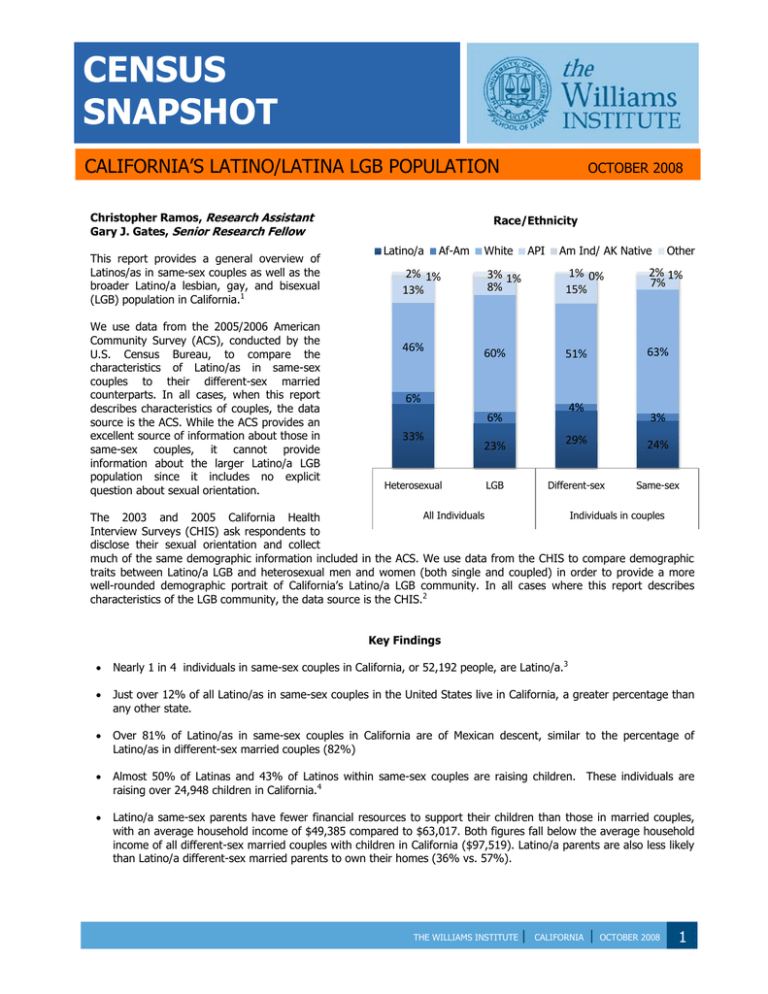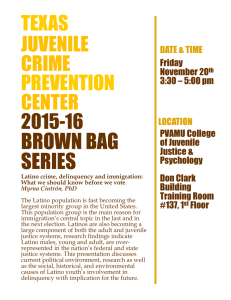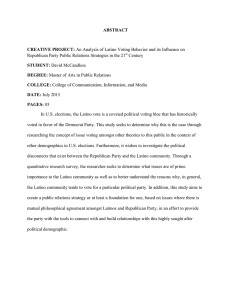
CENSUS
SNAPSHOT
CALIFORNIA’S LATINO/LATINA LGB POPULATION
Christopher Ramos, Research Assistant
Gary J. Gates, Senior Research Fellow
This report provides a general overview of
Latinos/as in same-sex couples as well as the
broader Latino/a lesbian, gay, and bisexual
(LGB) population in California.1
We use data from the 2005/2006 American
Community Survey (ACS), conducted by the
U.S. Census Bureau, to compare the
characteristics of Latino/as in same-sex
couples to their different-sex married
counterparts. In all cases, when this report
describes characteristics of couples, the data
source is the ACS. While the ACS provides an
excellent source of information about those in
same-sex couples, it cannot provide
information about the larger Latino/a LGB
population since it includes no explicit
question about sexual orientation.
OCTOBER 2008
Race/Ethnicity
Latino/a
Af-Am
White
API
Am Ind/ AK Native
Other
2% 1%
13%
3% 1%
8%
1% 0%
15%
2% 1%
7%
46%
60%
51%
63%
6%
4%
6%
33%
Heterosexual
23%
LGB
3%
29%
24%
Different-sex
Same-sex
All Individuals
Individuals in couples
The 2003 and 2005 California Health
Interview Surveys (CHIS) ask respondents to
disclose their sexual orientation and collect
much of the same demographic information included in the ACS. We use data from the CHIS to compare demographic
traits between Latino/a LGB and heterosexual men and women (both single and coupled) in order to provide a more
well-rounded demographic portrait of California’s Latino/a LGB community. In all cases where this report describes
characteristics of the LGB community, the data source is the CHIS.2
Key Findings
Nearly 1 in 4 individuals in same-sex couples in California, or 52,192 people, are Latino/a.3
Just over 12% of all Latino/as in same-sex couples in the United States live in California, a greater percentage than
any other state.
Over 81% of Latino/as in same-sex couples in California are of Mexican descent, similar to the percentage of
Latino/as in different-sex married couples (82%)
Almost 50% of Latinas and 43% of Latinos within same-sex couples are raising children. These individuals are
raising over 24,948 children in California.4
Latino/a same-sex parents have fewer financial resources to support their children than those in married couples,
with an average household income of $49,385 compared to $63,017. Both figures fall below the average household
income of all different-sex married couples with children in California ($97,519). Latino/a parents are also less likely
than Latino/a different-sex married parents to own their homes (36% vs. 57%).
THE WILLIAMS INSTITUTE
|
CALIFORNIA
|
OCTOBER 2008
1
MORE THAN 200,000 LATINO/A LESBIAN, GAY, AND
BISEXUAL ADULTS LIVE IN CALIFORNIA; 52,410
LATINO/AS IN SAME-SEX COUPLES
There are an estimated 200,000 LGB Latino/as in
California, comprising 2.4% of Latino/a adults in
California.
Latinos/as make up 23.4% of the state’s total LGB
population versus 32.9% of the total heterosexual
population.
CITIZENSHIP PATTERNS DIFFER BY SEXUAL
ORIENTATION AND COUPLING STATUS
Although Latino/as in same-sex couples have
similar citizenship rates to their Latino/a
counterparts in different-sex marriages, those in
same-sex couples are significantly more likely to
be citizens by birthright as opposed to
naturalization (49% vs. 33%).
Latino/as in either couple-type are about equally
likely to be a foreign citizen: 40% for those in
same-sex couples versus 43% for those in
different-sex married couples.
A similar pattern of citizenship is observed when
comparing lesbian, gay, and bisexual Latino/as
to their heterosexual counterparts. The 51% of
LGB Latino/as born in the U.S. compares to only
34% of heterosexuals. LGB (34%) and
heterosexual (48%) Latino/as have disparate
rates of non-citizenship.
Latino/as within same-sex couples and differentsex marriages are both largely of Mexican
descent, 81% and 82%, respectively; 15% of
Latino/as within same-sex couples come from
Central America and 4% from other Latin
American countries.
Among all LGB Latino/as, Mexico is the main
country of origin (71%); 15% were born in
Central America and 15% in South America or
the Caribbean.
Over a quarter (24%) of men and women in samesex couples are Latino/a, compared to 29% of those
in different-sex married couples.
LGB LATINO/AS ARE YOUNGER AND MORE URBAN
THAN HETEROSEXUAL LATINO/AS AND THE NONLATINO/A POPULATION
Approximately 58% of Latino/as in same-sex couples
are aged 18-39 compared to 46% of Latinos/as in
different-sex marriages.
Of LGB Latino/as, 77% are aged 18-39 compared to
64% of Latino/a heterosexuals.
Almost 90% of LGB Latino/as live in urban areas
compared to 78% of heterosexual Latino/as.
Heterosexual Latino/as are slightly more likely to live
in a suburban area (13%) than their LGB (9%)
counterparts; 9% of Latino/a heterosexuals live in
rural areas compared to 4% of LGB Latino/as.
All Latino/as
Latino/as in couples
Country of Origin
Same-sex
81%
Different-sex married
15%
82%
LGB
9%
71%
Heterosexual
15%
Central America
8%
15%
81%
Mexico
4%
15%
3%
Other Latin America
THE WILLIAMS INSTITUTE
|
CALIFORNIA
|
OCTOBER 2008
2
LATINO/AS IN SAME-SEX COUPLES ARE MORE
LIKELY TO BE IN AN INTER-ETHNIC
RELATIONSHIP
About 87% of Latino/as in married different-sex
couples are with another Latino/a, compared to
only 72% of Latino/as in same-sex couples.
MEN COMPRISE A MAJORITY AMONG LATINO/AS
IN SAME-SEX COUPLES AND THE LGB
POPULATION AT-LARGE
Among Latino/as in same-sex couples, a significant
difference exists, 58% are male and 42% are
female.
Males also make up a larger percentage of
the overall Latino/a LGB population, 53% to
47%.
LATINO MEN IN SAME-SEX COUPLES EARN LESS
THAN MEN IN MARRIED DIFFERENT-SEX
COUPLES
Latinos in same-sex couples have median individual
earnings of $25,100, over 20% less than the
median earnings for Latinos in different-sex married
couples ($32,000).
The figures for Latinas in California mirror previous
national findings; females in same-sex couples have
higher earnings than married women in differentsex couples.
Average Individual Earnings
of Coupled Latino/as
LGB LATINO/AS ARE ACTIVE
PARTICIPANTS IN CALIFORNIA’S
ECONOMY
Three percent of all LGB Latinos have served in the
military compared to 5% of Latino heterosexuals.
$37,078
$39,286
$33,763
The employment rate for Latino/as is 67%,
regardless of couple type.
$25,591
The percentage of LGB Latino/a individuals
who are employed (69%) exceeds that of
heterosexual Latino/as (67%).
LGB LATINO/AS HAVE RELATIVELY HIGH
LEVELS OF EDUCATION
Latinos/as
in
same-sex
couples
are
significantly more likely to have a college
degree (20% vs. 10%) than their differentsex married counterparts.
Similarly, LGB Latino/as are more likely than
their heterosexual counterparts to have a college
education (25% versus 9%).
Compared to the 47% of all LGB Californians and
the 32% of all heterosexuals whom hold at least a
college degree, Latino/as are less likely to have a
college degree (regardless of sexual orientation or
coupling status).
Men
Same-sex couples
Despite the military’s historic policies of excluding
LGB people from service, 6% of Latinos in samesex couples are veterans; 1.4% of Latinas in samesex couples have served in the military, a
significantly larger percentage than the 0.5% of
Latinas in married heterosexual couples.
Different-sex married couples
MEDIAN HOUSEHOLD INCOMES FOR LGB
LATINO/AS EXCEED THAT OF LATINO/A
HETEROSEXUALS YET ARE STILL WELL BELOW
THAT OF THE BROADER LGB POPULATION
Gay/Bisexual Latinos have a median household
income of $35,000 and lesbian/bisexual Latinas
have a median household income of $45,000,
compared to the $25,000 of heterosexual males
and females.
Gay/Bisexual Latinos have a lower median
household income than the larger gay/bisexual and
heterosexual population, both at $55,000.
LGB LATINO/AS HAVE ACTIVELY SERVED IN THE
UNITED STATES MILITARY
Women
THE WILLIAMS INSTITUTE
|
CALIFORNIA
|
OCTOBER 2008
3
LATINO/AS IN SAME-SEX COUPLES AND WITHIN
THE LARGER LGB POPULATION IN CALIFORNIA
HAVE LOWER HOMEOWNERSHIP RATES
Latinos/as
in
same-sex
couples
have
a
homeownership rate of 45% compared to 60%
among Latino/as in different-sex married couples.
The LGB Latino/a homeownership rate stands at
38%, less than the 42% homeownership rate of
heterosexual Latino/as.
Approximately 43% of Latinos within same-sex
couples and 50% of Latinas within same-sex
couples are raising children under the age of 18,
compared to 72% of married different-sex Latino/a
couples.
Among all Latino/a LGB individuals, both single and
coupled, 12% of men and 35% of women are
raising children, rates much higher than the overall
LGB population in which 6% of men and 25% of
women are raising children.
LATINO/A SAME-SEX PARENTS ARE RAISING
CHILDREN WITH FEWER ECONOMIC RESOURCES
THAN DIFFERENT-SEX MARRIED PARENTS
Latino/a same-sex parents have limited financial
resources to support their children with an average
household income of $49,385 compared to $63,017
for Latino/a married couples. Both figures fall below
the average household income of all same-sex
couples with children ($81,673) and different-sex
married couples with children ($97,519).
Latino/a parents in same-sex couples are also less
likely than Latino/a different-sex married parents to
own their homes (36% vs. 57%).
Latino/as, regardless of sexual orientation are less
likely to own their homes than the total
heterosexual population, 57% of whom own their
homes.
NEARLY HALF OF LATINO/AS WITHIN SAME-SEX
COUPLES ARE RAISING CHILDREN
Household income: Latino/as in couples raising children
$63,017
$50,200
$49,385
$35,000
Average household income
Same-sex couples
Median household income
Different-sex married couples
THE WILLIAMS INSTITUTE
4
|
CALIFORNIA
|
OCTOBER 2008
4
Table One: Characteristics of Latino/as in California
California Health Interview Survey
2003/2005, Age 18-70
LGB
American Community Survey
In a
same-sex couple
Heterosexual
In a different-sex
married couple
Sex
Male
Female
53.4%*
46.6%
51.5%
48.5%
58%^
42%^
51%
49%
30.5%*
46.8%
22.1%*
20.5%
43.7%
33.3%
3.8%
42.0%
47.6%
0.6%*
2.5%
12.7%^
44.8%
39.3%^
3.3%^
70.7%*
14.6%
81.3%
15.4%
81.3%
15.02%^
82.4%
9.5%
14.6%
3.1%
3.7%^
8.1%
0.0%
.1%
50.8%*
33.8%
48.6%^
33.3%
15.0%
34.2%*
18.5%
47.7%
11.0%^
40.4%
24.2%
42.6%
87.0%*
78.4%
9.4%
12.5%
3.6%*
9.0%
25.4%*
9.2%
19.8%^
9.8%
68.8%
66.5%
67.2%
66.8%
Men
$35,000
$25,000
Women
$45,000
$25,000
$37,078
$39,286
$33,763^
$25,591
Men
$25,100
$32,000
Women
$28,000
$20,000
3.9%
4.1%
Average age
18-24
25-39
40-64
65+
6.9%
Latino origin
Mexico
Central America
Other Latin
America
Europe
Citizenship status
Citizen by
birthright
Naturalized citizen
Non-citizen
Place of Residence
Urban
Suburban
Rural
Percent with a college
degree or better
Percent Employed
Median Household
Income
Average individual
salary
Men
Women
Median individual
salary
Veteran Status
Men
3.4%
5.4%
5.7%
Women
0.0%
0.3%
1.4%^
Homeownership
38.1%
42.4%
45.3%^
Percent with children
under 18
Men
12.2%*
49.8%
42.5%^
Women
35.0%*
62.0%
49.8%^
* Difference significant from heterosexuals at the 5% level or better (two-tailed tests).
^ Difference significant from different-sex married couples at the 5% level or better (two-tailed tests).
THE WILLIAMS INSTITUTE
|
CALIFORNIA
7.7%
.5%
59.9%
72.2%
72.2%
|
OCTOBER 2008
5
Table Two: Characteristics of Latino/as in couples with children, ACS only
In a same-sex couple
Average household income (parents)
In a different-sex couple
$49,385^
$63,017
Median household income (parents)
$35,000
$50,200
Homeownership
35.5%^
57.1%
* Difference significant from heterosexuals at the 5% level or better (two-tailed tests).
^ Difference significant from different-sex married couples at the 5% level or better (two-tailed tests).
1
Throughout this report we will use the terms “Latino/a” and “Latino/as” when referring to the population as a
whole, “Latino” or “Latinos” when referring to just males, and “Latina” or “Latinas” when referring to just females.
2
Characteristics of California’s gay/lesbian, bisexual, and heterosexual population are derived from the 2003 and
2005 California Health Interview Survey (CHIS). The CHIS is conducted by the UCLA Center for Health Policy
Research in collaboration with the California Department of Public Health, the Department of Health Care Services
and the Public Health Institute. It is funded by public agencies and private organizations. It is considered a
representative sample of the California population. Adults aged 18-70 are asked their sexual orientation along with
a variety of questions about their demographic, economic, and health characteristics. In most cases, we combine
samples from 2003 and 2005 to increase sample sizes and accuracy for the lesbian, gay, and bisexual respondents.
CHIS surveyed over 40,000 California households in each of those years. Estimates of demographic characteristics
for individuals in couples are made using an average of the 2005 and 2006 data of the Census Bureau’s American
Community Survey Public Use Microdata Samples (PUMS). The American Community Survey contains detailed
information about all members of the household, including citizenship, country of origin, and a variety of
demographic and economic characteristics.
3
Latino/a includes (1) all persons who did not identify themselves as “White” when completing their census forms,
and (2) all persons who identified themselves as “White,” but also as “Spanish/Hispanic/Latino.” For a more holistic
discussion of the various personal, instrumental, and external factors functioning around the construction of race
and ethnicity with specific focus on Latinos/as see: Rodriquez, Clara E. 2000. Changing Race: Latinos, the Census,
and the History of Ethnicity in the United States.
4
Computed by multiplying the number of same-sex couples times the percent of same-sex couples with children
times the average number of children under 18 in the household.
About the Authors
Christopher Ramos is a Research Assistant at the Williams Institute, UCLA School of Law. B.A. Pomona College.
He studies social inequality through a lens of race, class, gender, and sexual orientation.
Gary J. Gates is Senior Research Fellow at The Williams Institute, UCLA School of Law. Ph.D Carnegie Mellon. He
studies the demographic and economic characteristics of the lesbian and gay population.
For more information, contact:
The Williams Institute
UCLA School of Law
Box 951476
Los Angeles, CA 90095-1476
T (310)267-4382
F (310)825-7270
williamsinstitute@law.ucla.edu
www.law.ucla.edu/williamsinstitute
THE WILLIAMS INSTITUTE
|
CALIFORNIA
|
OCTOBER 2008
6





